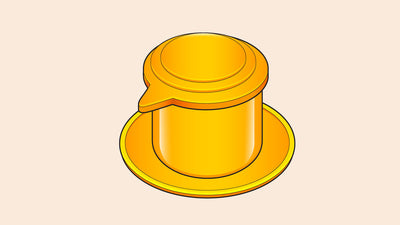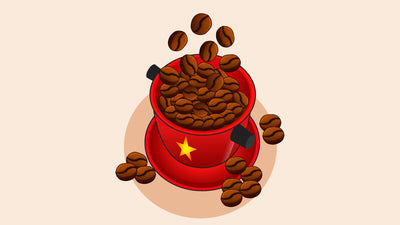Vietnamese coffee is typically prepared using dark-roasted robusta beans with a phin filter and served with sweetened condensed milk and ice.
There are 4 defining components of Vietnamese coffee:

- Origin — Vietnam is the second largest producer of coffee in the world. The rich, volcanic soil, perpetual growing season, and hefty rainfall mark the perfect conditions for cultivating coffee.
- Brew — Traditional Vietnamese coffee is brewed using a phin. This small metal filter sits on top of a mug and creates a slow-drip brewing process. The result is similar to an espresso but has up to two times the caffeine content, a thicker consistency, and a stronger taste.
- Preparation — Sweetened condensed milk is an essential ingredient in Vietnamese-style coffee, creating a delicious fusion of bold, creamy, and sweet flavors.
- Species — Traditional Vietnamese coffee is made exclusively from Coffea robusta, renowned for its strong, slightly bitter, and nutty flavor profile.
In this article, we explore the traditional Vietnamese brewing and serving process that sets it apart from other types of coffee.
What Makes Vietnamese Coffee Special?
One of the most obvious things that differentiates Vietnamese coffee from other types is that it’s grown in Vietnam.
Unlike other types of coffee, which tend to use the Coffea arabica bean or a blend of beans with a higher concentration of arabica, Vietnamese Coffee is made using only Coffea robusta.
Robusta contains up to two times the amount of caffeine compared to arabica and a much stronger flavor. In order to balance this bold, intense flavor, Vietnamese coffee also contains sweeteners (usually condensed milk).
The hot climate in Vietnam also means coffee prepared here is typically iced rather than kept hot.
How Vietnamese Coffee Compares to Other Types of Coffee Around the World:
|
Country |
Coffee Bean & Roast |
Flavor |
Brewing & serving method |
|
Vietnamese Coffee |
Robusta / Dark Roast |
Bold and intense |
Phin / condensed milk / ice |
|
American Coffee |
Arabica / Medium or Dark Roast |
Bright and clear |
Drip machine / black or with cream / flavored syrups / ice |
|
Japanese Coffee |
Arabica / Light to Medium Roast |
Sweet, mild, clean taste |
Pour over / cold brew / siphon / espresso |
|
Brazilian Coffee |
70% Arabica 30% Robusta / Medium to Dark Roast |
Nutty, bittersweet, low acidity |
Espresso / French press / cold brew |
Types of Vietnamese Coffee Drinks
Vietnamese coffee culture is vibrant and diverse — there are all kinds of unique flavors and preparations to explore.
Here are some of the most popular and trending Vietnamese coffee preparations used today:
- Vietnamese Iced Coffee (Cà Phê Sữa) — A blend of strong robusta coffee and condensed milk served over ice (cà phê sữa đá).
- Vietnamese Iced Latte (Bạc Xỉu)—Like an iced latte, this coffee is prepared in a tall glass of ice and condensed milk with a small amount of coffee. It offers a sweeter, less bitter drink than cà phê sữa. It is sometimes called SaiGon-style coffee.
- Vietnamese Black Coffee (Cà Phê Đen) — Strong black coffee without condensed milk, often enjoyed straight or with sugar.
- Phin Coffee (Cà Phê Phin) — Coffee made using a traditional Vietnamese phin filter, resulting in a bold flavor and a powerful caffeine kick.
- Vietnamese Egg Foam Coffee (Cà Phê Trứng) — Strong black coffee mixed with whipped egg yolks and condensed milk for a creamy, dessert-like drink.
- Yogurt Coffee (Sữa Chua Cà Phê) — Dark black coffee combined with Vietnamese yogurt, which is (as usual) sweetened with condensed milk.
- Coffee Smoothie (Sinh Tố Cà Phê) — Blended strong black coffee, tropical fruits, ice, and condensed milk.
- Cà Phê Muối (Salted Coffee) — Vietnamese iced coffee with a hint of salted cream or sea salt for extra flavor. Also called “shakerato coffee.”
- Cà Phê Chồn (Civet Coffee) — Coffee beans eaten and excreted by the Asian palm civet before being collected, washed, and roasted. One of the most expensive coffees on Earth.
- Coconut Coffee (Cà Phê Cốt Dừa) — Full-fat coconut milk and condensed milk heated and added to strong, black phin-brewed coffee.
- Pandan Coffee (Cà phê lá dứa) — A cold brew Vietnamese coffee mixed with pandan leaves (Pandanus amaryllifolius) and muscovado sugar.

A Brief History of Vietnamese Coffee

Vietnam was a French colony from 1883 to 1954. During this time, the French installed a rich coffee culture throughout the country, which continued to flourish over generations to evolve into what it is today.
Early French colonists were attracted to the fertile volcanic soil of Vietnam — particularly in Ninh Bình and Quảng Bình provinces.
Throughout France’s occupation, they could never get the coffee industry to boom. Labor shortages and devastating plant diseases like coffee rust destroyed their arabica plantations — leading to a significant shift towards the more resistant robusta variety.
After overcoming setbacks from the Vietnam War and the end of French rule, the Vietnamese government encouraged coffee production in the highlands through incentives such as tax exemptions and subsidies. This led to a resurgence in coffee farming, particularly of robusta, which saw a significant boom in the late 20th century.
Vietnam became a key player in the global coffee industry in the 1990s and has maintained this title ever since.
Vietnam is the Second-Largest Coffee Exporter in the World

In 2023, Vietnam exported 29.7 million bags of coffee — establishing them as the second largest producer in the world (behind Brazil at 39 million bags).
The majority of Vietnamese coffee exports consist of Coffea robusta (95%), but the country also produces arabica, cherri, moka, and culi coffee beans. Vietnam accounts for 50% of the world’s supply of robusta beans.
In terms of land mass, Vietnam ships roughly 2.9 tons of coffee per hectare of land. Compare this to Brazil, which produces about 1.4 tons per hectare.
How To Brew Authentic Vietnamese Coffee
The brewing process of Vietnamese coffee is important to get right if you want to achieve the bold, intense flavors this coffee is famous for.
Vietnamese coffee is traditionally brewed using a phin filter — which is a small metal filter that works like a cross between a French press and a drip coffeemaker.
A phin employs a slow-drip brewing process that allows the coffee to steep slowly and thoroughly over several minutes. This results in a stronger, more heavily caffeinated cup.
Once brewed, it's traditional to combine other ingredients, such as heavy condensed milk and ice, into the mix. Some people choose to add other flavors as well, such as caramel, cardamom, or vanilla, to further reduce bitterness.
If you want to try to make some at home, you can buy a phin from Cafely.com.
Tools & Ingredients

- Phin Filter — A small metal filter that combines immersion brewing (like a French press) and drip coffee systems to brew a strong, full-bodied coffee.
- High-quality Vietnamese Coffee — Choose freshly roasted Coffea robusta for best results. The stronger, the better. We recommend our Saigon OG blend (Robusta and Arabica blend), Hanoi (100% Vietnamese Peaberry Robusta) or Da Lat (Vietnamese Arabica)
- Sweetened Condensed Milk — Canned condensed milk provides the sweetness to balance the bold flavors of dark-roasted Vietnamese Robusta. You’ll need 2 tablespoons (30 mL) per 5 oz (148 ml) of coffee.
- Coffee Grinder — A burr grinder is preferable, but a blade grinder or small blender will do the job. Aim for a fine grind with a sand-like consistency.
- Hot water — You will need a ratio of around 1:2 or 1:4 coffee to water. The amount of water required will depend on the size of your phin kit.
- Ice (Optional) — Fill your cup to the brim with ice and pour freshly brewed coffee over the top. Skip this ingredient if you want a hot cup of coffee.
- Heat Resistant Mug or Glass Cup — Traditional Vietnamese iced coffee is served in a glass cup, but make sure it is heat resistant. The final brew will be cold, but you’ll still need to use hot coffee for the first pour.
Step-By-Step Instructions for Brewing Vietnamese Coffee
Check out our full brew guide to learn the ins and outs of brewing authentic Vietnamese-style coffee:
- Measure & Grind the Coffee — Use a medium-fine grind or order Cafely’s pre-ground coffee to skip this step.
- Assemble the Phin Filter — Place the filter plate on your cup and add the brew chamber. The gravity press and lid will be required later, so keep them on hand.
- Add Coffee Grounds — For a 6 oz filter, add about 21 grams (3 tablespoons) of coffee. Adjust depending on which filter you’re using.
- Add the Gravity Press — Even the coffee grounds by shaking the filter. Add the gravity press using very light pressure for even distribution.
- Add the Water (Bloom Stage) — First, add a small amount of water to "bloom" the coffee. This helps eliminate air pockets trapped between grinds to ensure a more consistent and efficient extraction. Pour enough water to cover the gravity press slightly, and allow 45 seconds for the gases to escape.
- Add the Rest of the Water (Extraction Stage) — Now, fill the chamber to the top with hot water and leave your phin to sit for 5–6 minutes to finish extracting.
- Add Sweetener — Traditional Vietnamese coffee is made with sweetened condensed milk, but you can use regular milk, sugar, or other creams to sweeten. We recommend 2 tablespoons (1 oz) of condensed milk.
- Add Ice (Optional) — Add enough ice to fill the volume of your cup. You want to bring the core temperature of the coffee down as quickly as possible. Let it sit for two minutes before drinking so it is nice and cool.
Feel free to experiment with the ratio of coffee to water and different sweeteners to suit your preferences.
Other Ways to Make Vietnamese Coffee

While the phin filter is the most traditional method of making Vietnamese coffee, you can use pretty much any brewing system to make it, too. The best Vietnamese coffee comes from brewing techniques known for crafting concentrated coffees. This means more diluted brewing methods like pour-over, drip coffeemakers, and siphon coffee aren't ideal. To compensate for this, some people simply use more coffee grounds than they normally would during brewing to get a stronger, more intense extraction.
Here are 4 brewing systems that can be used to make delicious Vietnamese coffee:
- French Press — Brew extra strong with a 1:2 or 1:3 ratio of coffee to water.
- AeroPress brewer — Use like a phin filter, allowing the hot coffee to drip through the press and into your cup. If the brew is taking to long, use the included plunger to force the coffee into your cup.
- Espresso machine — Use 1 shot of espresso for every 2 ounces of Vietnamese coffee.
- Moka Pot — Opt for Vietnamese robusta for the most authentic taste possible. Brew as normal and combine with condensed milk over ice.
Vietnamese Dessert Coffee Recipes
The versatility and intensity of flavors associated with Vietnamese coffee make it a perfect candidate for dessert coffees. Here are 4 of our favorite recipes for making delicious, innovative, and decadent coffees at home.
1. Vietnamese Ube Latte Recipe

Ube is a species of purple yam with a vibrant color and deliciously sweet and distinctive flavor. When combined with Vietnamese coffee, such as in ube latte iced coffee, it creates a visually stunning and uniquely flavored beverage.
What You Need:
- High-quality coffee
- Boiling water
- Vietnamese phin filter
- Unsweetened coconut milk/cream (canned, full-fat)
- Ube extract
- Syrup
- Vanilla extract
- Milk of choice
- Ice (optional)
- Heatproof cup and heat-resistant serving glass
- Whisk
- Measuring spoons
- Mixing bowl
Quick Steps:
- Brew the Coffee — Measure and grind coffee as needed, set up your phin filter over your cup, and brew using about 21 grams (3 tablespoons) of coffee. Allow for a bloom phase, then fill to just below the brim.
- Prepare the Ube Mix — In a mixing bowl, combine half a can of coconut milk with 2 teaspoons of ube extract, 3 oz of syrup, and 1/4 teaspoon of vanilla extract. Whisk until well mixed.
- Combine & Serve — Pour the ube mix into a serving glass, add ice and milk. Add your brewed coffee over the ube mix to create a layered effect. Enjoy the blend of traditional Vietnamese coffee with the delightful twist of ube flavor.
2. Vietnamese Egg Foam Coffee Recipe

The secret ingredient in this recipe is a deliciously sweet and silky egg foam, which is then used instead of condensed milk. It gives the coffee an incredible creamy texture.
What You Need:
- Ground coffee (quality robusta recommended)
- Sweetened condensed milk
- White sugar
- Egg yolks
- Boiling water
- Vietnamese phin filter
- Heat-proof bowl
- Electric beater
- Heat-resistant cup
Quick Steps:
- Prepare Egg Foam — Separate yolks from 2 eggs. In a mixing bowl, whisk 3 tablespoons of condensed milk and 1 teaspoon of sugar with the egg yolks until thick and foamy.
- Brew the Coffee — Measure 2 tablespoons of coffee and brew it using a 4-ounce phin filter. Adjust coffee according to the size of your phin.
- Combine & Serve — Pour your coffee into a cup filled with ice. Gently top with egg foam.
3. Vietnamese Coconut Coffee Recipe

This delicious coconut coffee combines robust Vietnamese flavors with the creamy richness of coconut milk, offering a tropical twist.
What You’ll Need:
- Vietnamese phin filter
- Coffee grinder (if using whole beans)
- Robusta coffee (pre-ground works too)
- Boiling water
- Canned, full-fat coconut milk/cream
- Sweetened condensed milk (or a dairy-free option)
- Heat-resistant glass cup
- Frother or shaker (optional)
Quick Steps:
- Grind Coffee: Grind your coffee to a fine consistency if using whole beans. Measure out two tablespoons of coffee.
- Set Up Phin: Place the phin filter over your cup and add coffee grounds. Use the press to tamp them down slightly.
- Brew Coffee: Pour enough boiling water to cover the grounds and let it bloom for 45 seconds. Then fill to just below the brim and let brew for 5-6 minutes.
- Heat Milk: Warm 1/3 cup coconut milk with 2-3 tablespoons condensed milk until hot but not boiling.
- Froth (Optional): Once brewed, you can froth the coffee or milk with a frother or by shaking vigorously.
- Combine & Serve: Mix the coffee with your heated milk mixture. Add toppings like shredded coconut if desired.
Full Guide: How to Make Vietnamese Coconut Coffee
The Vietnamese Phin Filter
At the heart of Vietnamese coffee culture sits the phin filter — a compact, drip-style coffee maker crafted from metal. It’s perfectly suited to the deep, rich, and intense flavors extracted by Vietnamese robusta coffee.
It was invented sometime in the 20th century and was quickly adopted for its low cost, simple design, and absence of disposable filters or waste. A good phin filter will last a lifetime of use.
This device is straightforward to use but might require some practice to get it just right.
Anatomy of a Phin Filter

The phin consists of 4 key parts:
- The Cap — Used to maintain the water's heat as the coffee brews.
- The gravity press — A small tamper to ensure a thorough and consistent extraction.
- The brew chamber — This is the body of the phin where the coffee steeps in water.
- The filter plate — A built-in filter separates the fresh coffee from the grounds (no paper filters needed).
What is Vietnamese Robusta Coffee?
Coffea arabica has been the world’s go-to coffee for a long time, but this bean is very finicky to grow. It requires very high altitudes, plenty of rain, and year-long growing seasons to thrive. Arabica grown in lower altitudes, even in tropical areas, develops a strong acidic flavor.
In Vietnam, the highest mountains rarely exceed 1500 meters in elevation. While there are farms in the higher central highlands growing arabica, most farms have switched to growing robusta — which thrives in lower altitudes, is drought-resistant, and produces consistent, high-quality yields all year long.
Through climate adaptations, along with a rich basalt soil that supports some of the highest quality coffee plantations in Southeast Asia, Vietnam has earned a name for the often maligned robusta bean.
The traditional brewing process for Vietnamese coffee is specially adapted for brewing robusta. The phin filter ensures a full extraction of the beans rich, earthy flavors, and the sweetened condensed milk does a perfect job of cutting the more bitter side of this intense bean.
Coffee may have been introduced to Vietnam by the French, but over the years, the local population has put their own spin on things to create coffee that the world has never seen before. You might think that we’re inventive in the Western world with our mochas, frappuccino coffees, and flavored lattes, but these likely wouldn’t cut the mustard in a place that has introduced egg, condensed milk, fermented rice, yogurt, and fresh fruit into their drinks.
Vietnamese Coffee vs. Other Southeast Asian Coffees
Coffee is popular throughout most of Southeast Asia, especially in Vietnam, Indonesia, and Malaysia. All 3 have developed their own unique culture, complete with distinctive recipes and bean varieties developed over generations.
The tropical climate of Southeast Asia is perfect for growing coffee. This part of the world accounts for 29 million bags of coffee annually.
Southeast Asian coffee styles typically use robusta (which thrives better in hotter regions with low altitudes), are prepared over ice, and combine local fruits and spices (such as coconut, chocolate, or cinnamon).
Examples of other Asian coffee styles:
- Thai Coffee (Oliang) — A blend of coffee, sesame seeds, and sometimes corn, served sweetened and iced.
- Indonesian Coffee (Kopi Tubruk) — Coffee where grounds are boiled along with sugar and served without filtering.
- Kopi Luwak — Made from coffee beans that have been digested and excreted by the civet, known for its distinctive and smooth flavor. (Called Cà Phê Chồn in Vietnam and Kapeng Alamid in the Philippines).
- Malaysian Coffee (Kopi-O) — Black coffee brewed using robusta and a traditional sock filter, served with sugar. Coffee served with milk is called Kopi Susu.
- Ipoh White Coffee — Coffee beans roasted with palm oil margarine and served with condensed milk. Very similar to Vietnamese butter-roast coffee. Popular in Malaysia.
- Filipino Barako Coffee — Made with Coffea liberica and known for its very strong flavor. Served hot, cold, black, or with milk.
- Laotian Coffee — Mostly robusta and arabica blends, often served strong and with sweetened condensed milk, similar to Vietnamese styles.
- Burmese Coffee (Café Yauk) — Typically brewed strong and served sweet with condensed milk, similar to Thai and Vietnamese coffee styles.
FAQs: Vietnamese Coffee

1. How much caffeine is in my cup of Vietnamese coffee?
A typical 4-ounce cup of Vietnamese coffee contains between 66 and 130 mg of caffeine. Caffeine levels can vary depending on whether brewing with robusta or arabica beans, roast level, and the volume of coffee brewed.
2. How much coffee is produced annually in Vietnam?
In the last year, 29.75 million bags of coffee were produced, and this figure looks set to rise in 2024 with its rise in popularity.
3. Is robusta coffee sustainable?
Yes! Robusta plants are hardier than arabica and need less specific altitudes and temperatures to thrive. Robusta plants require less attention and produce a higher yield than their arabica counterparts.
4. How is Vietnamese coffee different from other coffees?
Vietnamese coffee uses robusta beans, which are more robust and stronger in flavor compared to arabica. It also often features unique additions like condensed milk, yogurt, or egg yolk, giving it a distinct taste.
5. Can I brew Vietnamese coffee without a phin filter?
Yes, while a phin filter is the most traditional method, you can also use a French press, espresso machine, AeroPress, moka pot, or drip coffeemaker.
6. Can I make Vietnamese coffee without condensed milk?
Certainly! While sweetened condensed milk is the most common, you can enjoy Vietnamese coffee black or use alternative sweeteners like sugar, honey, or dairy-free creamers.
8. Is robusta coffee stronger than arabica?
Yes, robusta coffee typically contains almost twice as much caffeine as arabica, giving it a stronger flavor and more pronounced bitterness.
Related: Coffea robusta vs. Coffea arabica (Key Differences Explained).
9. Is Vietnamese Coffee Healthy?
Robusta coffee has many associated health benefits and can be a healthy beverage when used in moderation. Too much caffeine has side effects on the heart and liver, and an excess of sweetened condensed milk can lead to weight gain and metabolic changes.
















